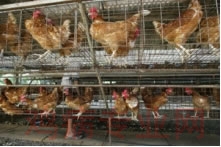联合国粮农组织警告:禽流感可能卷土重来
时间:2011-09-02
来源:石家庄神九所
2011年8月29日,联合国粮农组织发出警告,中国和越南发现了禽流感新的毒株,现有疫苗的保护率很差。各国须警惕禽流感卷土重来,特别是孟加拉、中国、埃及、印度和越南。
联合国粮农组织警告文章的网址:
http://www.fao.org/news/story/zh/item/87196/icode/(中文)
http://www.fao.org/news/story/en/item/87196/icode/(英文)
具体文章内容如下:
禽流感再次抬头
呼吁加强对变异菌株(注:原文如此,应为毒株)的防范和监视
2011年08月29日
2011年8月,罗马 有迹象表明H5N1型高致病性禽流感的变异菌株正在亚洲及其他地区传播,并给人类健康造成不可预知的威胁。为此,粮农组织今天呼吁加强防范和监测工作,以防该致命性疫病卷土重来。根据世卫组织的统计,H5N1型病毒自2003年首次出现以来,已感染565人,其中331人死亡。最新死亡病例上周发生在柬埔寨。该国今年已记录在案的人类感染病例达8起 – 均为致命性的。自2003年以来,因H5N1型病毒死亡或被扑杀的家禽超过400万只,在全球范围造成的经济损失约为200亿美元,63个曾在2006年疫病传播高峰期受到侵染的国家大部分已消灭了该病毒。然而,病毒仍在六个国家流行,虽然在家禽和野生鸟类种群中暴发的次数稳步减少,从高峰期的4000次降至2008年年中期的仅302次。但随后疫情暴发数量逐步增加,在2010-2011年记录了近800起。
病毒在家禽和野生鸟类中传播
此外,2008年显示出H5N1病毒在家禽和野生鸟类中传播的地理范围再度扩大。粮农组织首席兽医官胡安·卢布罗兹认为传播范围的扩展估计与候鸟的迁徙有关。他说,鸟类的迁徙有助于病毒远距离传播,导致在过去24个月里H5N1型病毒出现在一些国家的家禽或野生鸟类中,而这些国家几年来一直未出现过该病毒。“野生鸟类可能将病毒引入,但其传播者则是参与家禽生产和销售活动的人,”卢布罗兹博士指出。最近受影响的地区涉及以色列、巴勒斯坦、保加利亚、罗马尼亚、尼泊尔和蒙古。他说,另一个值得关注的问题是,在中国和越南出现了一个变种病毒,显然能够避开现有疫苗的防御。越南今年暂停了春季家禽疫苗接种工作,而在H5N1流行的北部和中部大多数地区,一种名为H5N1 – 2.3.2.1的新毒株已在传播。
高度警惕
越南的兽医部门高度警惕,据说正在考虑今年秋季开展一项新的和具有针对性的疫苗接种运动。病毒在越南的传播直接威胁着柬埔寨、泰国和马来西亚,以及更远的朝鲜半岛和日本。野生鸟类的迁徙也会将病毒传播至其他大洲。
“2004-2008年期间出现的逐步下降趋势的消失可能意味着H5N1病毒在今年秋季和冬季将会发作,人们会在其后院里意外地发现该病毒,”卢布罗兹说。他认为,孟加拉国、中国、埃及、印度、印度尼西亚和越南等一些H5N1病毒依然根深蒂固的国家所面临的形势可能最为严峻,但任何国家都不应掉以轻心。卢布罗兹强调:“对疫情的防范和监视仍然至关重要。绝不能满足于已经取得成绩。必须对H5N1保持高度警惕。”
Bird Flu rears its head again 29-08-2011
Increased preparedness and surveillance urged against variant strain

Major resurgence H5N1 possible
29 August 2011, Rome - FAO today urged heightened readiness and surveillance against a possible major resurgence of the H5N1 Highly Pathogenic Avian Influenza amid signs that a mutant strain of the deadly Bird Flu virus is spreading in Asia and beyond, with unpredictable risks to human health.
The H5N1 virus has infected 565 people since it first appeared in 2003, killing 331 of them, according to WHO figures. The latest death occurred earlier this month in Cambodia, which has registered eight cases of human infection this year -- all of them fatal.
Since 2003 H5N1 has killed or forced the culling of more than 400 million domestic poultry and caused an estimated $20 billion of economic damage across the globe before it was eliminated from most of the 63 countries infected at its peak in 2006.
However, the virus remained endemic in six nations, although the number of outbreaks in domestic poultry and wild bird populations shrank steadily from an annual peak of 4000 to just 302 in mid 2008. But outbreaks have risen progressively since, with almost 800 cases recorded in 2010-2011.
Virus spread in both poultry and wild birds
At the same time, 2008 marked the beginning of renewed geographic expansion of the H5N1 virus both in poultry and wild birds.
The advance appears to be associated with migratory bird movements, according to FAO Chief Veterinary Officer Juan Lubroth. He said migrations help the virus travel over long distances, so that H5N1 has in the past 24 months shown up in poultry or wild birds in countries that had been virus-free for several years.
"Wild birds may introduce the virus, but peoples' actions in poultry production and marketing spread it," Lubroth noted.
Recently affected areas are to be found in Israel and the Palestinian Territories, Bulgaria, Romania, Nepal and Mongolia.
A further cause for concern, Lubroth said, is the appearance in China and Viet Nam of a variant virus apparently able to sidestep the defences provided by existing vaccines.
In Viet Nam, which suspended its springtime poultry vaccination campaign this year, most of the northern and central parts of the country -- where H5N1 is endemic -- have been invaded by the new virus strain, known as H5N1 - 2.3.2.1.
High alert
Viet Nam's veterinary services are on high alert and reportedly considering a novel, targeted vaccination campaign this fall. Virus circulation in Viet Nam poses a direct threat to Cambodia, Thailand and Malaysia as well as endangering the Korean peninsula and Japan further afield. Wild bird migration can also spread the virus to other continents.
"The general departure from the progressive decline observed in 2004-2008 could mean that there will be a flareup of H5N1 this fall and winter, with people unexpectedly finding the virus in their backyard," Lubroth said.
The countries where H5N1 is still firmly entrenched – Bangladesh, China, Egypt, India, Indonesia and Vietnam – are likely to face the biggest problems but no country can consider itself safe, he said.
"Preparedness and surveillance remain essential," Lubroth underlined. "This is no time for complacency. No one can let their guard down with H5N1."
相关阅读:
石家庄神九所www.shenjiuyanjiusuo.com
1、禽流感新城疫病毒胶体金快速诊断试纸,十分钟即可捕捉病毒,眼观确诊疾病。补贴价供应实际需要者。
2、最新小RNA干涉基因片段,直接扑杀家禽体内的禽流感、新城疫、传支等病毒粒子。清除家禽体内潜伏的病毒。快速减少死亡、降蛋等情况。安全性高,无毒副作用。
3、新型大肠杆菌、沙门氏菌、里默氏菌克隆化自家苗技术,解决种禽场因此造成的雏禽早期大量死亡的难题。由于清除了大部灭活物质与内毒素,高峰期种禽与商品代场使用,不影响产蛋,同时大大减少用药量,大大降低死淘率。
技术咨询:刘会芳 13014374603 0311—80690515 QQ:1732264377
业务咨询:刘军同 15803214536 0311—80690520 QQ:1336096088
1、凡注明为其它媒体来源的信息,均为转载自其它媒体,转载并不代表本网赞同其观点,也不代表本网对其真实性负责。
2、您若对该内容有疑问,请即与本网联系,本网将迅速给您回应并做处理。
3、本网站将尽力保证服务的及时性、客观性,但不保证服务一定能满足用户的要求,也不保证服务不会受中断。本网站所提供的所有信息和数据服务仅限于用户参考,不对用户的商业运作做任何具体性指导。用户因参考本网站提供的信息所带来的一切风险及法律后果由用户自行承担。